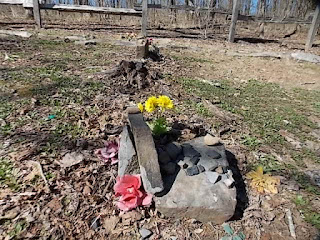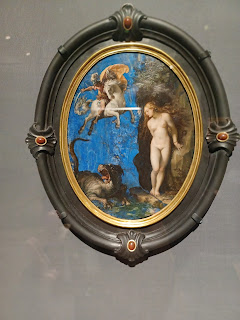John and I had a delightful time visiting two Arkansas artisans at work. The first place we stopped was Dryden Pottery in Hot Springs. The brochure we had seen regarding that store indicated that visitors could view demos of pottery being made. When we first came to Dryden Pottery place the building seemed quiet and the door locked. We waited a few minutes and soon Zachery Dryden let us in. He looked a bit tired, said he had been ill but would show us around. We thought that very kind of him.
Very quickly he started making a bowl out of what he called "mud". He explained that the mud was not just any mud, but a combination of materials which included clay. His Grandfather, James Dryden, started Dryden Pottery in Kansas. He later moved the business to Hot Springs because of the clay known to be available there. He was a chemical engineer and figured out what material worked best for making pottery. Zachery is the third generation of Drydens in the business- which makes for a culmination of 75 years in the pottery business for that family. After Zachery finished making the bowl he gave us a tour, showing us his three kilns ,warehouse and the store. The largest of his kilns is pictured below.
And speaking of large, check out the picture of the "World's Tallest Wheel Thrown Vase".
There are mirrors surrounding the vase, which gives it a three dimensional look,but it is one piece. If I remember correctly, Zachery said his Grandfather made it. His store is filled with many pottery pieces created by all three generations of Drydens. Quite an impressive inventory!
On another day we visited Chez Fur Fiber Farm, located in Malvern Arkansas. This is a working fiber farm of alpacas,sheep and goats. Their fiber is made into yarn which is carded,spun and knitted into cloth products. Bob Schafer, the owner, graciously let us feed and pet his animals.
The goats are pictured above, they were quite anxious for the corn we had in our hands. I did not know that true cashmere comes from kashmir goats. Bob's wife Kim uses all the fiber from the animals of their farm and turns them into finished goods. Bob also makes pottery, and one of their daughters does resin jewelry. After playing with the animals we entered their store which also had a very impressive inventory.
One very interesting story, which Bob told us, I would like to share here with my readers before closing this post. He has two Pyrenees sheep dogs, because of the presence of coyotes in the area. If there is danger present one of the dogs will gather the sheep into one corner of their pen and protect them, while the other will attack the coyote. That is in their natural instincts to react in that manner. He never has to worry about the safety of his animals because of those dogs.


.jpg)



.JPG)




.JPG)


.JPG)
.JPG)
.JPG)






















